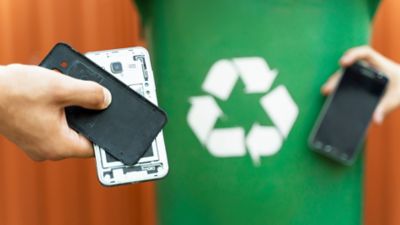-
-
Access Free Student Software
Ansys empowers the next generation of engineers
Students get free access to world-class simulation software.
-
Connect with Ansys Now!
Design your future
Connect with Ansys to explore how simulation can power your next breakthrough.
Countries & Regions
Free Trials
Products & Services
Learn
About
Back
Products & Services
Back
Learn
Ansys empowers the next generation of engineers
Students get free access to world-class simulation software.
Back
About
Design your future
Connect with Ansys to explore how simulation can power your next breakthrough.
Free Trials
ANSYS BLOG
February 6, 2023
Simulation Technology Helps Reduce E-Waste
Did you know that electronic waste, or e-waste, is the fastest-growing waste problem in the world? In fact, humans generate a staggering — and growing — 50 million metric tons of it annually. Thankfully, simulation technology can help us reduce e-waste and improve e-waste management solutions for this escalating global problem.
What is E-Waste?
E-waste refers to electric and electronic equipment that have exhausted their utility value through either redundancy, replacement, or breakage.
The Partnership on Measuring ICT for Development defines e-waste by categorizing it into six categories:
- Temperature exchange equipment — such as air conditioners, freezers
- Screens and monitors — such as TVs and laptops
- Lamps
- Large equipment — such as washing machines and electric stoves
- Small equipment — such as microwaves and electric shavers
- Small IT and telecommunication equipment — such as mobile phones and printers
Technology advances, consumer demand, and product life cycle reduction have contributed to e-waste gaining unwelcome distinction as the fastest-growing waste stream in the world. By 2030, annual e-waste production is on track to reach 75 million metric tons.
Many people buy new devices before the old ones have been properly recycled, which leads to a lot of e-waste. Additionally, many devices are not designed to be repaired or recycled. This leads to a lot of e-waste being improperly disposed of, which can negatively affect the environment and human health.

The Risks of E-Waste
Highly hazardous materials in e-waste — such as mercury, lead, arsenic, and brominated flame retardants — require special disposal. Yet according to a report from the Platform for Accelerating the Circular Economy (PACE) and the UN E-Waste Coalition, only a small fraction — 20% — of global e-waste is collected and properly recycled each year. This leads to serious environmental and health hazards, including pollution, releasing toxic materials into the air and water, and adverse health effects for people and animals. In addition, improperly recycled e-waste can also lead to data security risks.
E-waste can be deadly: from congenital disabilities to health issues in the central and peripheral nervous systems, e-waste has significant consequences for human well-being. Its effect on ecosystems can also be devastating — such as in the e-waste site located in Guiyu, China — where soil samples reflect some of the world's highest concentrations of toxic dioxins and heavy metals, making it impossible to grow food or drink safe water (lead recorded was 2,400 times higher than what is considered safe, according to the research).

Simulation-Driven Solutions to E-Waste
Simulation can play a pivotal role in helping innovators create new products quickly and cost-effectively. Simulation can be employed to reduce e-waste in four different ways.
1. Material Selection
It’s worthwhile to consider ways to reduce e-waste early in the product design phase using simulation. The first step is to ensure the products are made with materials with the lowest environmental footprints.
Products like Ansys Granta Selector focus on material-led, eco-design so engineers can factor in material sustainability earlier in the design process — helping to reduce product development time and make more sustainable material choices.
2. Topology Optimization
Another solution to e-waste includes reducing the amount of material used in the product.
For structural components of a product, a solid beam of metal or plastic might seem like the right option at first. But engineers can perform topology optimization analyses to show where material might be removed from the beam without compromising the strength of the beam. Topology optimization can produce unusual designs that an engineer might not first consider, but are strong enough to provide the necessary structural support needed for the product.
3. Electromagnetic Simulation
Electromagnetic materials can be minimized by simulating their properties and comparing the results to specifications. For example, engineers may be using a dielectric that is thicker than it needs to be to provide a margin of error in the electric insulating properties of components in a device. Electromagnetic simulations can be used to help to make the dielectric thinner while still providing the necessary electrical insulation. Similar simulations could be run to minimize the amount of material used in conductors, resistors, and other components.
4. Product Disassembly
Very few companies building electronic devices take disassembly into consideration when designing a product. Their first priority during the development stage is usually finding the most efficient way of assembling a component. But what if the way a component is assembled makes it easier to disassemble when the device has reached the end of its life cycle? That way it would be easier to extract valuable materials for recycling and reuse and to remove toxic materials so they don’t find their way into landfills.
Simulation enables engineers to explore more ways of arranging components and the order in which they are assembled in far less time than it would take to build a protype. Virtual design and testing using simulation makes it possible for engineers to consider assembly and disassembly during the design phase, which could lead to easier recycling of valuable materials and removal of toxic materials when the product is no longer usable.
To learn more about Ansys materials simulation technologies and the innovative companies leveraging simulation to rapidly accelerate toward a more sustainable future, watch the Ansys Earth Rescue online docuseries.